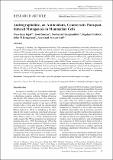| dc.contributor.author | Tajai, Preechaya | |
| dc.contributor.author | Suriyo, Tawit | |
| dc.contributor.author | Rangkadilok, Nuchanart | |
| dc.contributor.author | Fedeles, Bogdan I | |
| dc.contributor.author | Essigmann, John M. | |
| dc.contributor.author | Satayavivad, Jutamaad | |
| dc.date.accessioned | 2021-10-18T16:55:16Z | |
| dc.date.available | 2021-10-18T16:55:16Z | |
| dc.date.issued | 2021 | |
| dc.identifier.uri | https://hdl.handle.net/1721.1/133025 | |
| dc.description.abstract | © This work is licensed under a Creative Commons Attribution-Non Commercial 4.0 International License. Paraquat (1,1’-dimethyl, 4,4’-bipyridinium dichloride; PQ), a commonly used herbicide worldwide, is both toxic and mutagenic. The mutagenic effect of PQ stems from its ability to redox-cycle, generating oxidative stress and subsequently oxidative DNA damage, which miscodes when replication is attempted. Andrographolide (AP1), the major constituent in the leaves of the herbaceous plant Andrographis paniculata, is a diterpenoid with reported antioxidant activity. The present study employed the mammalian cell line AS52 to investigate the protective effect of AP1 against PQ-induced mutagenesis. AP1 induced cytotoxicity in AS52 cells in a dose-dependent manner (IC50 = 15.7 µM), which allowed the selection of a non-lethal dose for the mutagenesis studies. While PQ was mutagenic in AS52 cells as evidenced by the increased levels of 6-TGr mutants, AP1 by itself did not increase the mutation frequency. However, co-treatment with AP1 (1-5 µM) or the antioxidant N-acetylcysteine (2 mM) almost completely counteracted the mutagenicity of PQ (10-100 µM) in AS52 cells. Taken together, these findings suggest that AP1, and likely by extension, A. paniculata extracts, are effective antioxidants that can protect against PQ-induced mutations, and thus could be a promising alternative treatment for PQ poisoning. | en_US |
| dc.description.sponsorship | National Institutes of Health (Grants P30-ES002109, R01-CA080024 and P01- CA26731) | en_US |
| dc.language.iso | en | |
| dc.publisher | EpiSmart Science Vector Ltd | en_US |
| dc.relation.isversionof | 10.22034/APJCP.2020.21.S2.3 | en_US |
| dc.rights | Creative Commons Attribution NonCommercial License 4.0 | en_US |
| dc.rights.uri | https://creativecommons.org/licenses/by-nc/4.0/ | en_US |
| dc.source | Asian Pacific Journal of Cancer Prevention | en_US |
| dc.title | Andrographolide, an Antioxidant, Counteracts Paraquat- Induced Mutagenesis in Mammalian Cells | en_US |
| dc.type | Article | en_US |
| dc.identifier.citation | Tajai, Preechaya, Suriyo, Tawit, Rangkadilok, Nuchanart, Fedeles, Bogdan I, Essigmann, John M. et al. 2021. "Andrographolide, an Antioxidant, Counteracts Paraquat- Induced Mutagenesis in Mammalian Cells." Asian Pacific Journal of Cancer Prevention, 22 (S1). | |
| dc.contributor.department | Massachusetts Institute of Technology. Department of Biological Engineering | en_US |
| dc.contributor.department | Massachusetts Institute of Technology. Department of Chemistry | en_US |
| dc.contributor.department | Massachusetts Institute of Technology. Center for Environmental Health Sciences | en_US |
| dc.relation.journal | Asian Pacific Journal of Cancer Prevention | en_US |
| dc.eprint.version | Final published version | en_US |
| dc.type.uri | http://purl.org/eprint/type/JournalArticle | en_US |
| eprint.status | http://purl.org/eprint/status/PeerReviewed | en_US |
| dc.date.updated | 2021-08-27T17:27:06Z | |
| dspace.orderedauthors | Tajai, P; Suriyo, T; Rangkadilok, N; Fedeles, B; Essigmann, JM; Satayavivad, J | en_US |
| dspace.date.submission | 2021-08-27T17:27:07Z | |
| mit.journal.volume | 22 | en_US |
| mit.journal.issue | S1 | en_US |
| mit.license | PUBLISHER_CC | |
| mit.metadata.status | Publication Information Needed | en_US |
